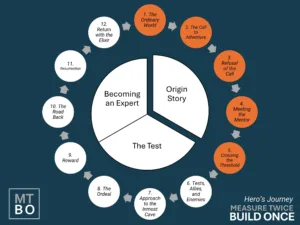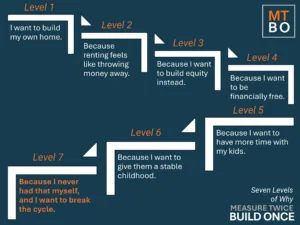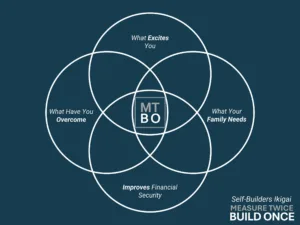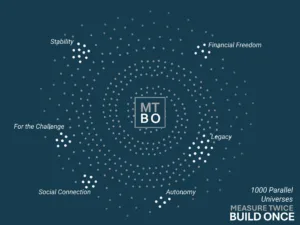|
Today we’re going over the 5/25 Rule to focus down a broad range of reasons to more specific reasons. The 5/25 rule is commonly attributed to Warren Buffett, although there’s no direct confirmation from him that he ever formally named it that way, it mostly comes from a story involving his pilot, Mike Flint. Here’s how it goes: The 5/25 Rule (Focus Rule)Step 1: Step 2: Step 3:
The Lesson:The point Buffett allegedly made is that the other 20 goals, while still important to you, are dangerous. Why? Because they’re distracting. They tempt you with a false sense of productivity but actually prevent you from going all-in on the Top 5. ✅ Your “Why” is the Top 5In the context of self-build, when someone is trying to understand why they want to build their own home, beyond just saving money or getting more space, they’re trying to uncover their core motivations. The 5/25 rule helps filter out the noise:
🛠 Applied to Self-Build:Let’s say someone comes to me or the MTBO Facebook Group and says: “I want to build my own home because I’m fed up with renting, want a garden, think it’s cheaper, and I like Grand Designs.”
The 5/25 exercise pushes them to go deeper. When they really sit with it, they might write the following:
Now we’re talking about identity, values, and long-term meaning, the real “Why.” Everything else is just surface level. Their motivation for building is deeply rooted in legacy, stability, and personal growth. They want to give their children the safe, secure home they never had, while also setting an example of courage and self-reliance. Their self-build isn’t just about bricks and mortar, it’s a symbol of long-term freedom, both financial and emotional. For them, building a home is about leaving something meaningful behind and proving to themselves (and their kids) that bold action creates a better future. “Write down 25 reasons you think you want to build your own home. Then circle the 5 that feel like they hit you in the gut. That’s probably your Why.”
What if I’m not sure?You may still be undecided if building a house is the way you want to go. The thing with this rule is that it can be applied at a higher level. Why not try it with your over-arching life desires first instead? I did this activity (though not actually realising it was the 5-25 Rule until recently) in 2016 and it helped me focus down and change from being an employee to being a contractor to afford my first house. I also parked my flying hobby as it fell out of my top 5. At the time I can remember feeling lost and a potential failure if I didn’t achieve everything on my list. The reality was that I needed to focus on just a few things and at the time for me that was my career, family, health and knowledge. As always, I’d love to hear from you. Hit this link to email me your top 5! Next up we are going to cover 1000 parallel universes, all at once. Might be a long one… – Brendan |

Framework
The Hero’s Journey – Reframing Yourself as the Protagonist
Find your “self-build why?” by using The Heros Journey.



